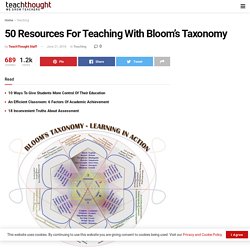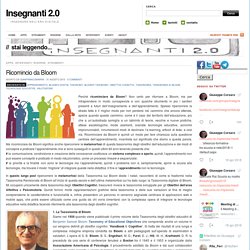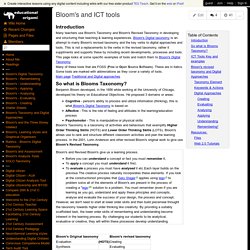

Smashin' Revised Bloom's Technology Tower. 50 Resources For Teaching With Bloom's Taxonomy - Simple suggestions for applying the taxonomy to kindergarten-level children.

Lesson Planet: This source gives the goods on creating complete lesson plans using Bloom’s Taxonomy. Prezi: Enjoy this stylish Prezi presentation on Bloom’s Taxonomy. Iowa State U.: This is a wonderful tool to build learning objectives based on Bloom’s Taxonomy. The Differentiator: Teachers and students can work together using this source to design creative activities; provides resources, content and the verbs. Slideshare: Based on Bloom’s Taxonomy, this presentation shows how to apply the principles for high-order technology skills. The Literary Link: This is a list of book review questions to use in the classroom.
Ricomincio da Bloom. Perché ricominciare da Bloom?

Non certo per ritornare a Bloom, ma per intraprendere in modo consapevole e con qualche strumento in più i sentieri presenti e futuri dell’insegnamento e dell’apprendimento. Spesso ripercorrere la strada fatta è il miglior modo per non perdersi nel cammino che ancora attende, specie quando questo cammino, come è il caso del territorio dell’educazione, più che a un’autostrada somiglia a un labirinto di teorie, vecchie e nuove pratiche, attese escatologiche, mode assillanti, svariate tecnologie educative, acronimi impronunciabili, innumerevoli modi di declinare l’e-learning, articoli di fede, e così via.
Ricominciare da Bloom è quindi un modo per fare chiarezza sulla questione centrale dell’apprendimento, incentrata sul significato che diamo a questa parola. How to Teach Vocabulary in the EFL Classroom - My English Language. Making new words memorable Teaching vocabulary is a vital part of any English language course.

Many teachers are concerned about how to teach vocabulary. New words have to be introduced in such a way as to capture the students’ attention and place the words in their memories. Students need to be aware of techniques for memorising large amounts of new vocabulary in order to progress in their language learning. English vocabulary learning can often be seen as a laborious process of memorising lists of unrelated terms. How to teach vocabulary to EFL students If English vocabulary is taught in an uninteresting way such as by drilling, simple repetition and learning lists, then the words are likely to be forgotten.
Teachers need to teach vocabulary so that the words are learned in a memorable way, in order for them to stick in the long-term memory of the student. Please see the Practice, presentation and production teaching method and the lesson plan suggestions for lesson and activity ideas. Educational Taxonomies with examples, example questions and example activities cognitive, psychomotor, and affective. Cognitive Domain: Bloom 1.

KNOWLEDGE: Knowledge is defined as the remembering of previously learned material. This may involve the recall of a wide range of materials, from specific facts to complete theories, but all that is required is the bringing to mind of the appropriate information. Knowledge represents the lowest level of learning outcomes in the cognitive domain. Description (to know to recall): Remembering previously learned material Lowest level of learning Listing learned information Remembering terms, methods, facts, concepts, specific items of information Sample Activities: Label the parts of a plant.
Group together all the four syllable words. Asks, chooses, describes, follows, gives, holds, identifies, locates, names, points to, selects, sits erect, replies, 2. Revised Bloom’s Taxonomy – CELT. Jump to the Bloom's Revised Taxonomy Model Go to the Flash version of the Bloom's Revised Taxonomy Model Download the PDF Version A statement of a learning objective contains a verb (an action) and an object (usually a noun).

The verb generally refers to [actions associated with] the intended cognitive process. The object generally describes the knowledge students are expected to acquire or construct. The cognitive process dimension represents a continuum of increasing cognitive complexity—from remember to create. The knowledge dimension represents a range from concrete (factual) to abstract (metacognitive) (Table 2). Educational Taxonomies with examples, example questions and example activities cognitive, psychomotor, and affective. Ep blooms wheel. 3.2 - How to Write Learning Objectives Using Bloom's Taxonomy. The Best Resources For Helping Teachers Use Bloom’s Taxonomy In The Classroom.
Bloom’s & SOLO ‘are not Just Colorful Posters we Hang on the Wall’ is my two-part series at Education Week Teacher.

Bloom’s Taxonomy is talked about a lot in educational circles. However, if you believe a recent survey of visits to 23,000 U.S. classrooms, the higher-order thinking skills it’s ideally designed to promote doesn’t get much use. And I can understand why. It’s easy to get caught-up in the day-to-day work involved in teaching a class or multiple classes, and it’s easy to fall into the trap of doing the “usual stuff” and not “think out of the box.” I thought it might be useful to share in a “The Best…” list the resources that help me try to use Bloom’s Taxonomy in my classroom. There may very well be resources out there that do a far better job of explaining the Taxonomy and how to use it. Blooms Taxonomy questions. Blooms Taxonomy Made Easy. Bloom's and ICT tools. Many teachers use Bloom's Taxonomy and Bloom's Revised Taxonomy in developing and structuring their teaching & learning experiences.

Bloom's Digital taxonomy is an attempt to marry Bloom's revised taxonomy and the key verbs to digital approaches and tools. This is not a replacements to the verbs in the revised taxonomy, rather it suppliments and supports these by including recent developments, processes and tools. This page looks at some specific examples of tools and match them to Bloom's Digital Taxonomy Many of these tools that are FOSS (Free or Open Source Software). These are in italics. Some tools are marked with abbreviations as they cover a variety of tools.Main pageTraditional and Digital approaches Benjamin Bloom developed, in the 1956 while working at the University of Chicago, developed his theory on Educational Objectives.
Files Web 2.0 Tutorials Without a doubt one of the best resources on the web for web2.0 Technologies is the commoncraft show.